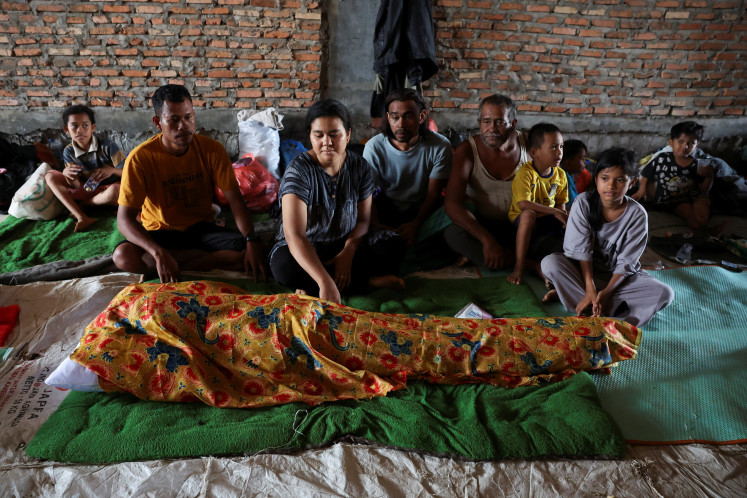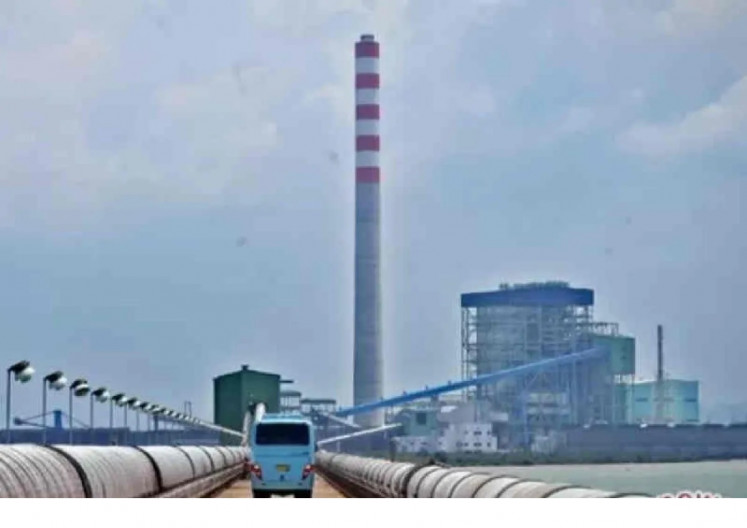Popular Reads
Top Results
Can't find what you're looking for?
View all search resultsPopular Reads
Top Results
Can't find what you're looking for?
View all search resultsOppenheimer back with 'The Look of Silence'
(Courtesy of Final Cut For Real)If The Act of Killing brought Indonesian viewers the surreal and stomach-turning admissions of communist-purge executioners, The Look of Silence provides the painful and powerfully arresting reality of mass-murder survivors
Change text size
Gift Premium Articles
to Anyone
 (Courtesy of Final Cut For Real)" border="0" height="344" width="597">(Courtesy of Final Cut For Real)
(Courtesy of Final Cut For Real)" border="0" height="344" width="597">(Courtesy of Final Cut For Real)If The Act of Killing brought Indonesian viewers the surreal and stomach-turning admissions of communist-purge executioners, The Look of Silence provides the painful and powerfully arresting reality of mass-murder survivors.
As he promised, director Joshua Oppenheimer has returned with another documentary about the pitch-black section of Indonesian history surrounding the widespread killings in the country in 1965 and 1966.
The Look of Silence premiered at the 71st Venice Film Festival in Italy on Aug. 28. On the same day, a limited screening of the film was held for journalists in Jakarta. The documentary will also be screened at the Toronto International Film Festival in Canada and the Telluride Film Festival in Colorado, the US.
Oppenheimer said that The Act of Killing was haunted by the absent victims, which created an empty ruined landscape, inhabited by a lost and lonely figure.
âThe Look of Silence is the movie where we step into those haunted spaces and feel viscerally what it is like for the survivors forced to live there, forced to build lives under the watchful eyes of the men who murdered their loved ones, and remain powerful,â the Copenhagen-based director said in a statement.
In the new documentary, the audience follows Adi, an optician whose older brother Ramli was brutally and inhumanly murdered during the purge in Deli Serdang regency, North Sumatra.
Adi and his family â his proud and stern mother Rohani as well as his very old but playful father Rukun who, because of his health, is reliant on his wife â discover how Ramli was murdered and the identity of his killers through Oppenheimerâs work for The Act of Killing.
 Adi puts himself in front of a former 1965 executioner who has become a wealthy and respected citizen in a scene of The Look of Silence. (Courtesy of Final Cut For Real)
Adi puts himself in front of a former 1965 executioner who has become a wealthy and respected citizen in a scene of The Look of Silence. (Courtesy of Final Cut For Real)
Rohani thinks of Adi, who was born two years after the killing, as a replacement for Ramli. She attributes her sanity and her ability to live on after Ramliâs death to Adi. He has lived with that burden his whole life.
Adi, determined to step out of the blanketing fear and break the silence of victims, steels himself to meet and confront the men responsible for his brotherâs gruesome death.
The father of two bravely and calmly puts himself in front of the people involved in Ramliâs killing, among whom are a well-known legislator, a respected elder and a close relative of the family.
Adi faces his own fear and the fear of his family, who become more distressed after knowing that he set out to meet the people involved in the purge.
Oppenheimer said that he began the filming project upon his return to North Sumatra in 2003 after visiting the province for the first time in 2001 to help oil-palm plantation workers make a film documenting and dramatizing their struggle to organize a union. He then learned of stories of the 1965 killings and of the fear terrorizing the villagers.
He began investigating one murder that was discussed frequently by the plantation workers, about a victim whose name was Ramli, and was considered representative of the massive killings in the area.
 (Courtesy of Final Cut For Real)<)
(Courtesy of Final Cut For Real)<)
(Courtesy of Final Cut For Real)
If The Act of Killing brought Indonesian viewers the surreal and stomach-turning admissions of communist-purge executioners, The Look of Silence provides the painful and powerfully arresting reality of mass-murder survivors.
As he promised, director Joshua Oppenheimer has returned with another documentary about the pitch-black section of Indonesian history surrounding the widespread killings in the country in 1965 and 1966.
The Look of Silence premiered at the 71st Venice Film Festival in Italy on Aug. 28. On the same day, a limited screening of the film was held for journalists in Jakarta. The documentary will also be screened at the Toronto International Film Festival in Canada and the Telluride Film Festival in Colorado, the US.
Oppenheimer said that The Act of Killing was haunted by the absent victims, which created an empty ruined landscape, inhabited by a lost and lonely figure.
'The Look of Silence is the movie where we step into those haunted spaces and feel viscerally what it is like for the survivors forced to live there, forced to build lives under the watchful eyes of the men who murdered their loved ones, and remain powerful,' the Copenhagen-based director said in a statement.
In the new documentary, the audience follows Adi, an optician whose older brother Ramli was brutally and inhumanly murdered during the purge in Deli Serdang regency, North Sumatra.
Adi and his family ' his proud and stern mother Rohani as well as his very old but playful father Rukun who, because of his health, is reliant on his wife ' discover how Ramli was murdered and the identity of his killers through Oppenheimer's work for The Act of Killing.
Adi puts himself in front of a former 1965 executioner who has become a wealthy and respected citizen in a scene of The Look of Silence. (Courtesy of Final Cut For Real)
Rohani thinks of Adi, who was born two years after the killing, as a replacement for Ramli. She attributes her sanity and her ability to live on after Ramli's death to Adi. He has lived with that burden his whole life.
Adi, determined to step out of the blanketing fear and break the silence of victims, steels himself to meet and confront the men responsible for his brother's gruesome death.
The father of two bravely and calmly puts himself in front of the people involved in Ramli's killing, among whom are a well-known legislator, a respected elder and a close relative of the family.
Adi faces his own fear and the fear of his family, who become more distressed after knowing that he set out to meet the people involved in the purge.
Oppenheimer said that he began the filming project upon his return to North Sumatra in 2003 after visiting the province for the first time in 2001 to help oil-palm plantation workers make a film documenting and dramatizing their struggle to organize a union. He then learned of stories of the 1965 killings and of the fear terrorizing the villagers.
He began investigating one murder that was discussed frequently by the plantation workers, about a victim whose name was Ramli, and was considered representative of the massive killings in the area.
Adi freezes as he sees 1965 executioners boast about their killing. (Courtesy of Final Cut For Real)
Ramli's death was public, with witnesses giving accounts of his final moments and explaining that his body was left in the plantation, a few kilometers from his parents' home.
Like on The Act of Killing, Oppenheimer worked with Indonesian collaborators, who remain anonymous, for the 98-minute-long documentary.
Quoted by euronews.com during the documentary premiere in Venice, Oppenheimer said the project had been a frightening film to shoot.
'It meant that Adi's family had to move thousands of kilometers to another part of Indonesia. We tried to get them out of the isolation of North Sumatra and away from the men who did this to their family,' he said.
Up close
The anonymous crew is planning to screen the documentary in cities across Indonesia on Dec. 10, to observe the international Human Rights Day. The team is inviting Indonesian communities and groups to hold independent screenings of the documentary on the same day by contacting the crew through its website, www.filmsenyap.com.










